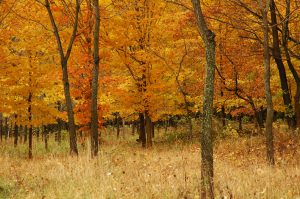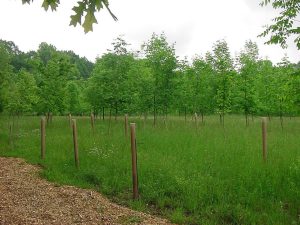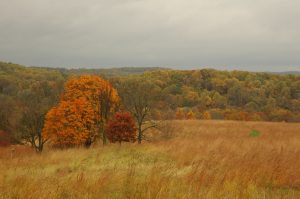Seeing the Forest for the Trees
Photos courtesy of Bill Moses and Natural Lands30 years at Binky Lee Preserve
 Darin Groff was 19 when he began working for Natural Lands. It was 1990. George H. W. Bush was in the White House, the internet was in its infancy, and cigarettes had just been banned on domestic flights. And Binky Lee Preserve, an 89-acre property in Chester Springs, had just been donated to Natural Lands by the Seiple family, who had named the farm after a beloved horse.
Darin Groff was 19 when he began working for Natural Lands. It was 1990. George H. W. Bush was in the White House, the internet was in its infancy, and cigarettes had just been banned on domestic flights. And Binky Lee Preserve, an 89-acre property in Chester Springs, had just been donated to Natural Lands by the Seiple family, who had named the farm after a beloved horse.
“Most of the land was in hay back then,” Darin recalls. “Harvesting it was a challenge because Binky Lee is so hilly, and we worried we’d flip the tractor. This land isn’t suited for farming — it’s way too steep and the soil just erodes. It’s meant to be a forest.”
Binky Lee, like the rest of southeastern Pennsylvania, had been a forest for millennia before it was colonized by Europeans. When William Penn first visited in 1682, almost 99% of the nearly 29 million acres that’s now Pennsylvania was covered in trees. Adequate rain, rich soil and moderate temperatures make our region ideal for forest growth. In fact, if you leave the land to its own devices, farm fields, meadows and even lawns will quickly give way to woody plants.
So, Darin started planting trees. White oak, American sycamore, white pine, sugar maple, ash and hickory, just to name a few. About 50,000 trees over the decades, with help from land stewardship colleagues and volunteers.
Thirty-three years later, Binky Lee Preserve is a thriving example of the transformative effect of afforestation (establishing a forest where no recent tree cover existed). A third of the 112-acre property is wooded with the balance as meadow, which Darin — who’s been preserve manager there for two decades — mows annually to control woody and invasive plant growth.
Natural Lands stewardship staff plant seedlings in rows spaced about 10 feet apart, leaving enough room for mowing, which keeps invasive plants at bay. While this even planting pattern may look unnatural at first, other native species — like tuliptree and spicebush — fill in the gaps through natural succession. Once the trees are large enough and begin shading the ground beneath — usually after about a decade — the land stewards can stop mowing and simply spot treat invasives as needed.

Each seedling is protected by photodegradable tree tubes, which shelter the tender plants from deer and create a mini-greenhouse to stimulate early tree growth.
The final step in an afforestation project is to help these new forests establish healthy understories. Nature often provides this essential layer on its own as seeds drop from nearby trees or helpful birds, but Natural Lands often accelerates this process. Planting hardy native shrubs that can outcompete invasive species helps establish the forest understory more quickly, protecting our investment and minimizing maintenance needed for these new woods to thrive.
The oldest of Binky Lee’s new forests are more than 30 years old. But all that work is worth the wait.
These woods create essential habitat for wildlife, including birds that rely on dense forests for food, breeding, shelter and migration corridors. They bolster important ecological services like slowing and soaking up floodwaters, producing oxygen, drawing carbon from the atmosphere, and cooling temperatures. When planted along streams, they prevent erosion, reduce flooding, and help improve aquatic life and water quality.
 What’s more, creating and improving forest habitat is perhaps the most cost-effective way to tackle the climate crisis. As trees grow, they absorb and store the carbon dioxide emissions that are driving global warming. In its January 2020 report, “CarbonShot,” the World Resources Institute suggested that reforestation and afforestation will be key for the U.S. to have any hope of reaching carbon neutrality by 2050.
What’s more, creating and improving forest habitat is perhaps the most cost-effective way to tackle the climate crisis. As trees grow, they absorb and store the carbon dioxide emissions that are driving global warming. In its January 2020 report, “CarbonShot,” the World Resources Institute suggested that reforestation and afforestation will be key for the U.S. to have any hope of reaching carbon neutrality by 2050.
Despite the incredible impact trees can and will have on climate in the coming decades, changing weather patterns and rising temperatures require us to adjust what species we include in afforestation projects.
Northern tree species that are close to the southern extent of their range face increased stress and population decline, while southern or temperate species are spreading northward. Natural forest regeneration is threatened as vulnerable seedlings succumb to weather extremes like drought and deluges. Forest pests and pathogens, as well as invasive species, are expanding their range as temperatures warm, taking advantage of stressed trees.
“We’ve begun selecting more climate- resilient species for Natural Lands’ afforestation projects. We’re putting in more American sycamore, hackberry, boxelder, black gum and eastern hophornbeam,” says Darin. “Instead of red oak, we’re selecting black oak, white oak and chestnut oak species.”
Darin adds, “The climate is changing so rapidly — tree species don’t have time to adapt. So, we adapt instead.”
Natural Lands is dedicated to preserving and nurturing nature’s wonders while creating opportunities for joy and discovery in the outdoors for everyone. As the Greater Philadelphia region’s oldest and largest land conservation organization, member- supported Natural Lands has preserved more than 135,000 acres, including 42 nature preserves and one public garden. Nearly 5 million people live within 5 miles of land under Natural Lands protection. Land for life, nature for all. NatLands.org.
